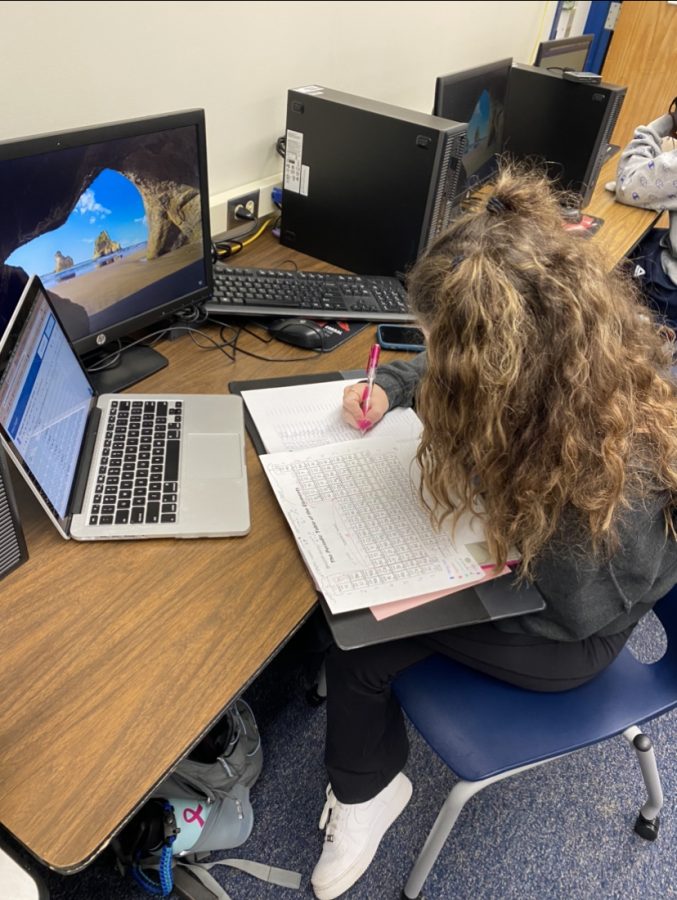Battling Winter Burnout
Dealing with the stress of finals and the upcoming semester
November 19, 2021
Sometimes just thinking about writing that essay or getting up for school can completely exhaust a person. The term “burnout” was created to describe the feeling of being completely worn, physically and mentally, due to your job. Over time this term was adopted by teenagers and their relationship with school. Burnout can sometimes be hard to notice, especially in a fast paced work environment. However, some Parkway Central High Students seem to be familiar with the topic.
“During the school year, I start experiencing burnout within the first month of school starting because it is hard to keep everything together with sports, school, and social life.” Ellie Sioumcas (10) says. This is an example of one of the causes of burnout; thinking about how much you’ve done and how much more you need to do. It can be easy to argue that there will always be another task to complete, but maybe there are ways to lessen the stress.
“The school could get rid of standardized tests like finals and get teachers to cut down on busy work.” Kiah Couchman (11) says. The best way to deal with burnout is to prevent its start. Once a person has already started experiencing the side effects, it can be challenging to get back to a normal rhythm. But how would one go about preventing this mental block?
Before burnout even begins, especially around the second semester of school, it is vital to take steps to keep away the stress. One way to prevent burnout is to exercise. Keeping yourself in shape and creating goals can help counteract the burnout that can result from stress. Picking up a winter sport or getting a gym membership may be good ways to get in the necessary exercise to keep burnout away. Another way to prevent burnout is to stay on a good and consistent sleep schedule. Finding the right amount of hours you need to get each night will help keep your focus and energy up. Most teenagers need between seven and nine hours of sleep each night, so figuring out where you fit best will greatly benefit your mood and motivation throughout the day. The last, and arguably most important way to prevent burnout, is asking for help. When faced with tests, essays, finals, and homework, it is important to ask for help when needed. Whether it’s from a teacher, friend, or parent, just having support can decrease stress by a landslide.
Hopefully this list got to you before the burnout. If not, there are ways to face it. Before learning how to get rid of burnout, it is important to identify it. Some of the signs of burnout include increased absences, disengagement, exhaustion, increased mistakes, withdrawal, and higher sensitivity. Sometimes an increase in procrastination and lack of motivation can be signs as well. After finding out what burnout is and how to identify it, it is time to conquer it.
One of the best ways to manage burnout is to start your day by doing something productive. This productive thing does not have to include writing your English paper or going for a jog. Making your bed or cleaning up your room are two great ways to start the day on the right foot. If getting out of bed is the issue, try to find something that you really love, and treat yourself to it when you wake up. For example if you’re a coffee lover, always have some ready to go in the morning. If staying focused in school is an issue there are plenty of ways to help. In a note-taking or lecture based class, taking notes with colorful pens can help keep you engaged. If the class is reading based, put a piece of candy on each page and treat yourself to it when you finish that page. When doing homework the best ways to stay engaged are staying in a designated workspace, keeping your phone away, and most importantly taking breaks. A DeskTime study concluded that a 52-minute focus and 17-minute break is the best balance for studying. Others prefer 90 full minutes of work and a 20-30 minute break. When doing a task that you have been putting off, 25-minutes of work time and a five minute break may work better. Overall, there are many ways to prevent burnout, and even more ways to cure it. The best way to deal with the stress of school differs for each person, but hopefully some of these tips will help.



